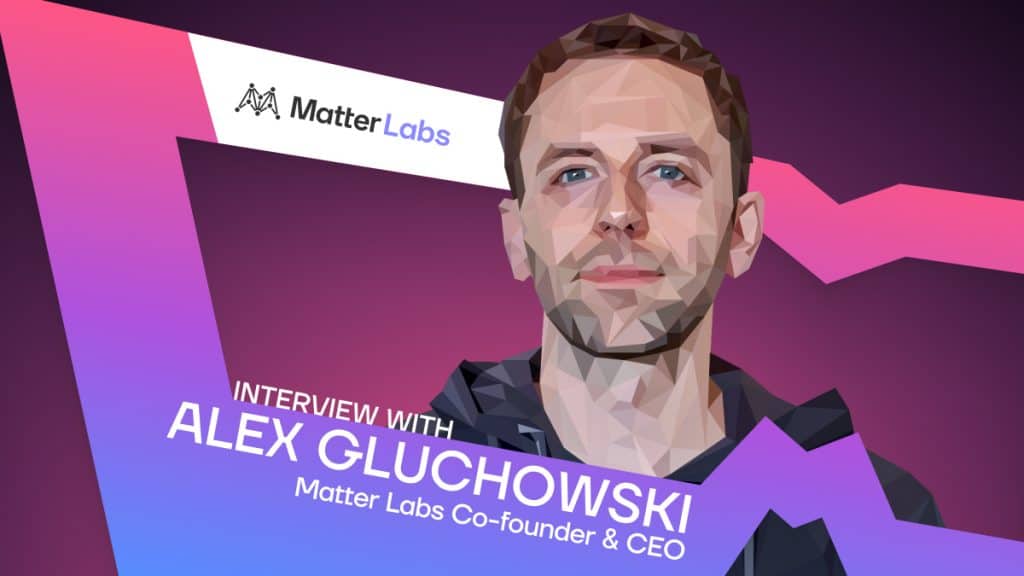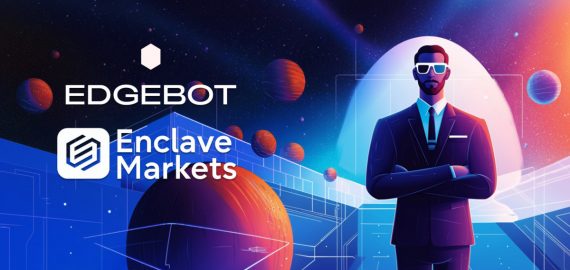Matter Labs Co-founder & CEO Alex Gluchowski on Pioneering zkSync and Transforming Blockchain Scalability


In Brief
Metaverse Post co-founder Sergei Medvedev spoke to Matter Labs CEO Alex Gluchowski about the world of zkSync.
Gluchowski outlined zkSync’s multi-layered security strategy.
zkSync will soon reveal new functionalities that take advantage of zero-knowledge proofs.

Over the past year, the blockchain community has been buzzing with discussions surrounding zero-knowledge proofs (ZK proofs) and ZK Roll-ups. As developers search for scalable solutions to tackle the challenges of mainstream blockchain adoption, the spotlight has now turned to the burgeoning potential of these zero-knowledge technologies.
Alex Gluchowski, CEO and co-founder of Matter Labs, stands at the forefront of this movement. The founders’ brainchild, zkSync, an Ethereum Layer-2 (L2) protocol, has emerged as a pivotal force boosting blockchain scalability.
In an exclusive interview with Metaverse Post’s co-founder Sergei Medvedev, Gluchowski offers a glimpse into the highly technical world of zero-knowledge proofs.
He delves into the genesis of zkSync, illuminating the journey that has catalyzed its transformative influence on the evolving Web3 ecosystem.
Moreover, Gluchowski teases forthcoming innovations that are set to redefine the current L2 landscape.
The Birth of zkSync
Gluchowski’s journey began five years ago when he recognized the potential of zero-knowledge proofs before they matured into a viable solution. He recounts, “We were doing our job and saw the potential of zero-knowledge proofs before they even became productized.”
Zero-knowledge proofs, or ZK proofs, serve as cryptographic protocols with exceptional properties that distinguish them from other L2 protocols.
“Zero-knowledge proofs are super generic,” Gluchowski says, emphasizing the technology’s versatility in enabling proof of complex computations’ correctness — without divulging sensitive information.
Matter Labs recently published a detailed vision for the company’s philosophy and values, titled “ZK Credo.” In the manifesto, the company specifically outlined its beliefs on the transformative potential of zero-knowledge proofs and how it can serve as a cornerstone in realizing its guiding principles.
“Few important properties include trustlessness, censorship, resistance, and inclusivity. Anyone can fully participate in the system; decentralization is an overall motif. All of that becomes possible with zero-knowledge proofs at scale,” Gluchowski explains.
“It’s the only technology we have today that allows us to break out of the blockchain trilemma and scale blockchains to an arbitrary degree, bringing billions of people with no theoretical upper cap. You can add more servers, more processing power, GPUs, and chains, which will observe more use cases at high throughput while remaining very, very broadly decentralized.”
zkSync’s Multi-Layered Security Strategy
Amidst the ongoing scalability concerns within the blockchain sphere, Gluchowski and his Matter Labs team initiated a mission to amplify Ethereum’s scalability using ZK proofs, upholding its fundamental tenets. This initiative yielded zkSync — an Ethereum network Layer 2 (L2) based protocol and scaling remedy.
“zkSync uses SNARKs to scale Ethereum while fully preserving the properties that make Ethereum valuable in the first place,” Gluchowski adds.
The launch of zkSync Era in March marked a significant milestone in Matter Labs’ journey.
To ensure a seamless and secure deployment, the team implemented a multi-layered security approach.
“The first pillar of security is the construction of the protocol,” Gluchowski says, underlining the protocol’s secure design.
He reveals that Matter Labs participated in audit and security contests with Code4rena and invested over $3 million in various audit procedures to strengthen the protocol’s integrity.
According to Gluchowski, the second pillar of the protocol involves a two-factor approach.
This not only relies on the usage of zero-knowledge proofs to validate the chain’s integrity but also incorporates confirmation from the sequencer, affirming the validity of the blocks.
Gluchowski noted that this layered security mechanism guarantees a comprehensive shield against potential threats.
“An attacker would have to break both the ZK, the cryptography and the sequencer layer in order to try to compromise the system,” he elaborates.
Gluchowski reveals that the roll-up framework has integrated a third layer of defense. This extra protection incorporates a temporary withdrawal delay, acting as a training wheel for the roll-up’s ongoing development phase.
If an exploitation attempt occurs, this delay acts as a buffer, granting the security team and external monitors up to 24 hours to promptly identify and address potential vulnerabilities.
“You never want to rely on a single mechanism for security, you always want to make sure that you have multiple independent mechanisms, even if one or several of them are failing, then you have a safety net that can save you from the problem,” Gluchowski explains.
Hyperchains and zkSync Era’s Influence
The launch of zkSync Era marked the inception of the first chain built on the ZK stack. Gluchowski coins the term “hyperchain” for this innovative category of chains, envisioning a future where numerous hyperchains interconnect via a network of hyperbridges.
According to Gluchowski, any chain built upon the foundational ZK stack assumes the identity of a hyperchain. Thanks to its open-source framework and adaptability, these hyperchains are particularly attractive to those searching for customized blockchain solutions.
“You’re free to customize all aspects of the developer experience. You can introduce your data availability model, use your sequencer, have a decentralized or centralized sequencer for some use cases, work with customer data availability, and you can have privacy out of the box because you don’t have to publish all the transactions for some enterprise or commercial use cases,” he elaborates.
Gluchowski emphasized the potential for developers to introduce their native tokens and tailored tokenomics. This empowers organizations to stake and construct chains that serve their specific communities or applications.
He pinpointed two prominent trends in the realm of hyperchains — one centers around decentralized entities crafting application-specific chains to meet their needs and develop crypto-native products.
The second trend involves enterprises transitioning from the web2 landscape, gaming sector, and traditional banking and finance domain. These entities adopt blockchain technology to gain more operational control.
As part of this shift, they actively create customized chains that need integration into the Ethereum global network.
“They want to derive security from Ethereum. They understand that they can bootstrap security from scratch; the idea of building your own L1 is probably dead. And this is deeply understood by most people we’re speaking to.”
Ankr and Matter Labs recently joined forces to launch dedicated zk Era nodes and hyperchains on the Microsoft Azure Marketplace. Speaking on the partnership, Gluchowski says, “It will make it a lot easier for people to deploy hyperchains and operate them.”
zkSync Era’s Anticipated Airdrops
With the public availability of zkSync Era, insights into upcoming airdrops have piqued the interest of retail participants. Delving into this matter, Gluchowski shed light on the decision-making process behind such announcements.
“We have the first airdrop live on Era now. We just released the LIBERTAS OMNIBUS project as a fun experimental encouragement for our NFT community,” says Gluchowski.
The project, designed to engage the NFT community, has distributed rewards to over 100,000 users who engaged with top NFT collections launched on zkSync.
Highlighting the importance of community involvement, Gluchowski enthuses: “I find it extremely interesting and important for the community to feel ownership and feel part of the channels and really having fun interacting with the product.”
On Running Matter Labs as CEO and Co-Founder
Gluchowski contemplates how his responsibilities evolved within Matter Labs from CTO to CEO.
Previously, he focused on leading technical teams and navigating complex challenges in a profoundly technical organization dedicated to developer solutions.
As CEO, his role shifted towards managing company growth, yet Gluchowski highlights his ongoing involvement with the technology and product departments.
“Most of my time is still spent in the tech and product areas,” he adds.
Balancing the technical and growth facets presented a challenge, yet Gluchowski found solace in assembling a dynamic core team.
“I found some really smart people who were part of the core team, and I think we’ve built an amazing team,” he says.
This diverse team spans technology and non-technological domains, ensuring a comprehensive and holistic approach to Matter Labs’ operations.
Deliberately pursuing a compact team, Gluchowski strives for an environment where personal connections endure. “We intend to maintain a small organization, no more than 150, at most 200 individuals. This way, I can personally know everyone within the organization,” he explains, emphasizing the value of impactful contributions.
“You’re not just a small mechanism in this huge machine. You’re actually very important. I aim to preserve that essence. So I want to keep that. And this also follows Ethereum’s philosophy of subtraction, which is one of the central themes of the Ethereum Foundation,” he remarks.
Gluchowski asserts that the company aims to excel in a singular expertise. For Matter Labs, this implies scaling Ethereum and building an L2 protocol tailored to what he calls “hyperscale.” This aspiration aligns with a fundamental belief that zero-knowledge proofs possess the potential for limitless scalability.
The trajectory is further guided by a detailed engineering roadmap and a precise vision for the protocol’s ultimate state, which is yet to be unveiled.
Gluchowski envisions a pluralistic ecosystem where Matter Labs is one of many ZK protocol contributors. This decentralization roadmap is more than theoretical; it gains traction as Matter Labs engages with various companies active in the ZK stack arena.
To promote collaboration, Matter Labs is readying the release of an open list of research and development inquiries. “We’ll be rather happy to support, invest and give grants to help others build other parts of the protocol,” Gluchowski asserts, embodying the ethos of a decentralized and all-encompassing blockchain ecosystem.
Gluchowski’s Favorite zkSync and ZK Proof Use Cases
“My favorite use cases revolve around the fantastic user experiences that blockchain can offer, where we can take the Web2 use cases and make them a lot better and at the same time non-custodial, providing people with the freedom to own their assets in the fullest,” Glushowski tells Metaverse Post.
In this initial development phase, Gluchowski acknowledges the ongoing evolution of user experience and wallets striving to match Web2 application functionality. “Now, for example, we have native account abstraction on zkSync. And we’re only seeing the first big applications being built that take full advantage of the need for account abstraction,” he observes, recognizing the interplay between applications and wallet infrastructure.
Nevertheless, he says that zkSync will soon reveal new functionalities that take advantage of zero-knowledge proofs.
This journey has begun with Boojum, a new proof system now live on the mainnet in shadow-proving mode.
“For each block, we generate the proof in the old proof system, and we also generate the proofs in the new proof system to make sure that everything works exactly the same way as it was intended,” Gluchowski adds.
Upon the completion of testing, Boojum will fully switch Goodrum, a proof system with a marked improvement in performance, as affirmed by Gluchowski.
Gluchowski outlines that these improvements encompass heightened throughput, accelerated Oracle updates, broader functionalities in decentralized finance (DeFi), and even the prospect of elevating social media and NFT capabilities to unprecedented levels.
“We’ll see a lot of really interesting things happening this fall on zkSync,” hints Gluchowski, alluding to an upcoming era of innovation and scalability for the protocol.
Keep track of cryptocurrency distributions in our Airdrops Calendar.
Disclaimer
In line with the Trust Project guidelines, please note that the information provided on this page is not intended to be and should not be interpreted as legal, tax, investment, financial, or any other form of advice. It is important to only invest what you can afford to lose and to seek independent financial advice if you have any doubts. For further information, we suggest referring to the terms and conditions as well as the help and support pages provided by the issuer or advertiser. MetaversePost is committed to accurate, unbiased reporting, but market conditions are subject to change without notice.
About The Author
Serial entrepreneur with 14+ years experience. Transformed Cointelegraph from 1M to 19M MAU and launched 8 local branches. Now helping corporates make the shift to web3.
More articles

Serial entrepreneur with 14+ years experience. Transformed Cointelegraph from 1M to 19M MAU and launched 8 local branches. Now helping corporates make the shift to web3.


















































